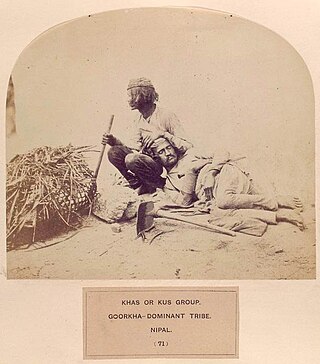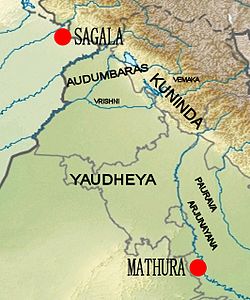
The Kingdom of Kuninda was an ancient central Himalayan kingdom documented from around the 2nd century BCE to the 3rd century, located in the southern areas of modern Himachal Pradesh and far western areas of Uttarakhand in northern India and Doti Gadwall in Nepal.

The Satluj River is the longest of the five rivers that flow through the historic crossroads region of Punjab in northern India and Pakistan. The Sutlej River is also known as Satadru. It is the easternmost tributary of the Indus River. The Bhakra Dam is built around the river Sutlej to provide irrigation and other facilities to the states of Punjab, Rajasthan and Haryana.

Khas people, popularly known as Khas Arya, are an Indo-Aryan ethno-linguistic group native to the Himalayan region of the Indian subcontinent, in what is now the present-day South Asian country of Nepal, as well as the Indian states of Uttarakhand, West Bengal and Sikkim. Historically, Khas were the speakers of an ancient Khas language from the Indo-Aryan language family and the earliest recorded speakers of the Western Pahari languages. The large portion of the Indo-Aryan speakers throughout lower Himalayas were the Khas people. An intrusion of this tribe from the Western and Northwestern Himalayas into Central Himalayas is substantiated by the early linguistic evidences related to the Nepali language. They were also known as Parbatiyas/Parbates and are currently known as Paharis/Pahadis.. They were also referred to as Yartse in Tibet and are also known as Khasan by Bhotia people. The term Khas has now become obsolete, as the Khas people have adopted communal identities because of the negative stereotypes associated with the term Khas. In Nepal the native speaker of Nepali language are known as Khas.

Khasas were an ancient Indo-Aryan tribe and a late Janapada kingdom from Himalayan regions of northern Indian subcontinent mentioned in the various historical Indian inscriptions and ancient Indian Hindu and Tibetan literatures. European sources described the Khasa tribe living in the Northwest Himalayas and the Roman geographer Pliny The Elder specifically described them as "Indian people". They were reported to have lived around Gandhara, Trigarta and Madra Kingdom as per the Mahabharata.
Bazigar, or Goaars, are an ethnic group of north-western India. They are primarily found in Punjab and in Pakistan's Punjab, but there are also communities in Haryana, Uttar Pradesh, Delhi, Chandigarh, Himachal Pradesh, Jammu and Kashmir, and Rajasthan. They were previously nomadic with their main occupation the performance of acrobatics and other forms of entertainment, but they are now settled and engaged mainly in agricultural and similar forms of labour.
The Hill States of India were princely states lying in the northern border regions of the British Indian Empire.

Uttarkashi District is a district of Garhwal division of the Uttarakhand state in northern India, and has its headquarters at Uttarkashi city. It has six Tehsils namely Barkot, Dunda, Bhatwadi, Chinyalisaur, Purola and Mori.
Katoch is a Chandravanshi Rajput clan. Their traditional areas of residence was Trigarta Kingdom, Jalandhar, Multan i.e. the areas of residence are mainly in the Indian states of Punjab, Uttarakhand, Himachal Pradesh and Jammu. and at Kangra Fort. They descent from the Trigarta dynasty mentioned in the Mahabharata. Historically, they ruled from Multan, Jalandhar, and Kangra. The Multan Fort (1000-800 B.C and Kangra fort were also built by Katoch clan, establishing their antiquity. Katochs have only 4 sub-clans that came into existence from Katoch Rajputs are Dadwal Dynasty, Guleria Dynasty, Sibaia Dynasty, Jaswal Dynasty.

Doaba, also known as Bist Doab or the Jalandhar Doab, is the region of Punjab, India that lies between the Beas River and the Sutlej River. People of this region are given the demonym "Doabia". The dialect of Punjabi spoken in Doaba is called "Doabi". The term "Doaba" or "Doab" is derived from Persian دو آب meaning "land of two rivers". The river Sutlej separates Doaba from the Malwa region to its south and the river Beas separates Doaba from the Majha region to its north.

Himachal Pradesh was established in 1948 as a Chief Commissioner's Province within the Union of India. The province comprised the hill districts around Shimla and southern hill areas of the former Punjab region. Himachal became a part C state on 1951 with the implementation of the Constitution of India. Himachal Pradesh became a Union Territory on 1 November 1956. On 18 December 1970 the State of Himachal Pradesh Act was passed by Parliament and the new state came into being on 25 January 1971. Thus Himachal emerged as the eighteenth state of the Indian Union.
According to the Mahabharta, the present day Himachal Pradesh consisted of a number of small republics also known as the Janpadas..
- Audumbras – They were one of the most ancient tribes of Himachal who resided in the lower hills of Pathankot and Jwalamukhi. They formed a separate province in 2 B.C.
- Trigarta – The state was laid in the foothills drained by 3 rivers, namely- Ravi, Beas and Satluj. It is believed that the state was an independent republic.
- Kuluta – The kingdom of Kuluta was located in the upper Beas valley which is also known as the Kullu valley. The state capital was Naggar.
- Kulindas – The kingdom covered the area between the Beas, Satluj and Yamuna rivers. The administration resembled a republic with the members of central assembly sharing the powers of the head.
- Guptas – Chandragupta captured the republics of the Himachal by the use of his force though he usually did not rule them directly. Ashoka, his grandson extended his boundaries to the Himalayan region. He introduced Buddhism to the state. He built various stupas here.
- Harsha – After the collapse of Guptas and before the rise of Harsha, the area was again ruled by chiefs also known as Thakurs and Ranas. With the rise of Harsha in the 7th century, most of these small provinces acknowledged its allround supremacy though many local powers remained with the chiefs.
- Rajput Period – After Harsha's death Rajput states ascended in Rajasthan and Indus plains. They moved to the hills with their followers, where they established small provinces or principalities. Some of these were Kangra, Nurpur, Suket, Mandi, Kutlehar, Baghal, Bilaspur, Nalagarh, Keonthal, Dhami, Kunihar, Bushahar, Sirmour.
Gurjar is an Indo-Aryan agricultural ethnic community, residing mainly in India, Pakistan and Afghanistan, divided internally into various clan groups. They were traditionally involved in agriculture, pastoral and nomadic activities and formed a large heterogeneous group. The historical role of Gurjars has been quite diverse in society: at one end they have been founders of several kingdoms and dynasties and, at the other end, some are still nomads with no land of their own.
The Batwal are a suryavanshi rajput clan found in the Indian states of Rajasthan, Madhya Pradesh, Maharashtra, Jammu and Kashmir, Punjab and Himachal Pradesh.
Mankotia is an Indian surname belonging to a Rajput clan. The clan predominantly resides in the Indian states of Himachal Pradesh and Jammu and Kashmir. The name originates from the town Mankot, now Ramkot, Jammu and Kashmir.

The Bodh people, also known as Khas Bhodi, are an ethnic group of Himachal Pradesh, India. They are found in Lahaul tehsil, Lahaul and Spiti district, predominantly in the Bhaga and Chandra valleys, but also to a lesser extent in Pattani valley, Miyar Valley, in the upper reaches of Pangi, Himachal Pradesh and Paddar valley, Jammu and Kashmir. Their religion is predominantly Buddhism with animistic and shaivite practices. Caste wise, they are identified as Rajput, Thakur or Kshetri although caste rules are not as rigid as in the plains. Historically, 3-4 prominent families of the area were accorded the titles of Rana, Wazir or Thakur by the kings of Chamba, Kullu or Ladakh for the purpose of general administration and revenue collection. They have a mix of martial traditions alongside shamanistic and lamaistic beliefs. Certain families/clans used to be significant zamindars/jagirdars. There is a significant cultural and ethnic mixing due to the region passing under the hegemony of rulers of Ladakh, Kullu and Chamba over the last many centuries. The language spoken differs from valley to valley with some dialects being very close to Kumaoni, while others are mixed with Chambyali and Dari. They are progressive, enterprising, honest and were involved in the centuries old India-Tibet-Nepal trading routes. Organized into family groups/clans with clan names ending in the suffix "-pa" similar to the "-ta" suffix found in the family/clan names of the Simla area.
Shamirpur is a town in the Kangra district of the Indian state of Himachal Pradesh. It is located next to National Highway 20, which runs from Pathankot in Punjab to Mandi in Himachal Pradesh. It is easily accessible from Dharmasala. The nearest airport is Gaggal Airport, alternatively known as Kangra Airport or Dharamsala-Kangra Airport, which is located in Gaggal near Kangra, 14 kilometres (8.7 mi) southwest of Dharamshala.
Rajputs of Nepal or anciently Rajputras are Rajput Kshatriya community of Nepal.
Dadwal, also written as Dadhwal and Dhadwal, is a surname prevalent in Punjab, Himachal Pradesh and Jammu. The surname is prevalent in the Rajput community. It is also prevalent in the Jatt community and is a clan name amongst Hindus and Sikhs.
The Rajputs in Himachal Pradesh are members of the Rajput community living in the North Indian Himalayan state of Himachal Pradesh. They ruled a majority of kingdoms of the region and even dominate in Himachal Pradesh politics. The kingdoms of the Hill States of India were mostly in the present day state of Himachal Pradesh, and mostly had Rajput rulers. All of the Chief Ministers who served Himachal Pradesh except for Shanta Kumar belong to the Rajput caste. The Rajputs of Himachal Pradesh fought battles with Tughlaq, Mughal, and Sikh forces, most notable being the Battle of Bhangani, when the Hill States made an alliance against the Sikhs. While some Rajput kingdoms and clans have a long history in Himachal Pradesh, others were established due to the Rajput migrations to the hill regions mostly due to the Islamic invasions.
Hun or Huna is an ancient clan of the Gurjar ethnic community of Pakistan, Afghanistan, and India. Historically, they were also known by the name of Huna. They are primarily Hindu, while some are Muslim in Kashmir and Pakistan. In mountainous areas, they speak the Gujari language, as well as other indigenous dialects.








